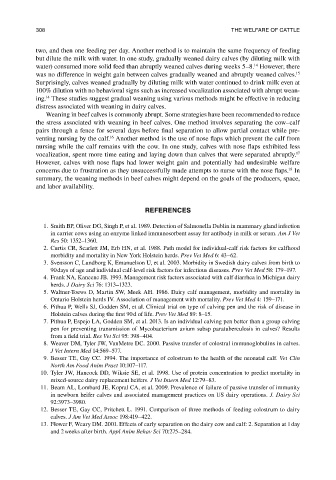Page 331 - The Welfare of Cattle
P. 331
308 the WeLfare of CattLe
two, and then one feeding per day. Another method is to maintain the same frequency of feeding
but dilute the milk with water. In one study, gradually weaned dairy calves (by diluting milk with
14
water) consumed more solid feed than abruptly weaned calves during weeks 5–8. However, there
15
was no difference in weight gain between calves gradually weaned and abruptly weaned calves.
Surprisingly, calves weaned gradually by diluting milk with water continued to drink milk even at
100% dilution with no behavioral signs such as increased vocalization associated with abrupt wean-
14
ing. These studies suggest gradual weaning using various methods might be effective in reducing
distress associated with weaning in dairy calves.
Weaning in beef calves is commonly abrupt. Some strategies have been recommended to reduce
the stress associated with weaning in beef calves. One method involves separating the cow–calf
pairs through a fence for several days before final separation to allow partial contact while pre-
16
venting nursing by the calf. Another method is the use of nose flaps which prevent the calf from
nursing while the calf remains with the cow. In one study, calves with nose flaps exhibited less
17
vocalization, spent more time eating and laying down than calves that were separated abruptly.
However, calves with nose flaps had lower weight gain and potentially had undesirable welfare
concerns due to frustration as they unsuccessfully made attempts to nurse with the nose flaps. In
18
summary, the weaning methods in beef calves might depend on the goals of the producers, space,
and labor availability.
reFereNCeS
1. Smith BP, Oliver DG, Singh P, et al. 1989. Detection of Salmonella Dublin in mammary gland infection
in carrier cows using an enzyme linked immunosorbent assay for antibody in milk or serum. Am J Vet
Res 50: 1352–1360.
2. Curtis CR, Scarlett JM, Erb HN, et al. 1988. Path model for individual-calf risk factors for calfhood
morbidity and mortality in New York Holstein herds. Prev Vet Med 6: 43–62.
3. Svensson C, Lundborg K, Emanuelson U, et al. 2003. Morbidity in Swedish dairy calves from birth to
90 days of age and individual calf-level risk factors for infectious diseases. Prev Vet Med 58: 179–197.
4. Frank NA, Kaneene JB. 1993. Management risk factors associated with calf diarrhea in Michigan dairy
herds. J Dairy Sci 76: 1313–1323.
5. Waltner-Toews D, Martin SW, Meek AH. 1986. Dairy calf management, morbidity and mortality in
Ontario Holstein herds IV. Association of management with mortality. Prev Vet Med 4: 159–171.
6. Pithua P, Wells SJ, Godden SM, et al. Clinical trial on type of calving pen and the risk of disease in
Holstein calves during the first 90 d of life. Prev Vet Med 89: 8–15.
7. Pithua P, Espejo LA, Godden SM, et al. 2013. Is an individual calving pen better than a group calving
pen for preventing transmission of Mycobacterium avium subsp paratuberculosis in calves? Results
from a field trial. Res Vet Sci 95: 398–404.
8. Weaver DM, Tyler JW, VanMetre DC. 2000. Passive transfer of colostral immunoglobulins in calves.
J Vet Intern Med 14:569–577.
9. Besser TE, Gay CC. 1994. The importance of colostrum to the health of the neonatal calf. Vet Clin
North Am Food Anim Pract 10:107–117.
10. Tyler JW, Hancock DD, Wiksie SE, et al. 1998. Use of protein concentration to predict mortality in
mixed-source dairy replacement heifers. J Vet Intern Med 12:79–83.
11. Beam AL, Lombard JE, Kopral CA, et al. 2009. Prevalence of failure of passive transfer of immunity
in newborn heifer calves and associated management practices on US dairy operations. J. Dairy Sci
92:3973–3980.
12. Besser TE, Gay CC, Pritchett L. 1991. Comparison of three methods of feeding colostrum to dairy
calves. J Am Vet Med Assoc 198:419–422.
13. Flower F, Weary DM. 2001. Effects of early separation on the dairy cow and calf: 2. Separation at 1 day
and 2 weeks after birth. Appl Anim Behav Sci 70:275–284.

